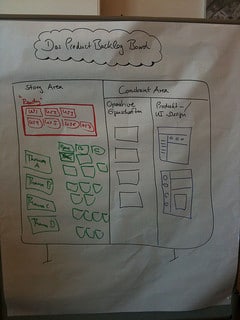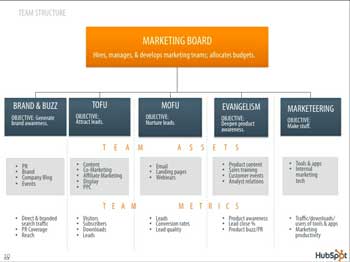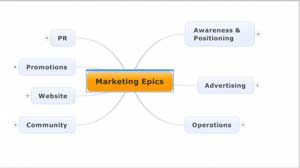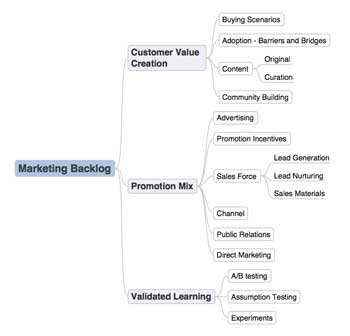
Agile Developers structure their product backlogs into stories, epics and themes. Agile Marketers could apply the same approach, but often they do something slightly different. Let’s take a look at three different approaches from HubSpot, MindJet and my own consulting practice to structuring an Agile Marketing Backlog.
HubSpot
HubSpot structures both their marketing team and their Agile Marketing Backlog around their sales funnel. They structure their marketing team into five distinct groups:
- Brand & Buzz – generate brand awareness
- Top of the Funnel – attract leads
- Middle of the Funnel – nurture leads
- Evangelism – deepen product awareness
- Marketeering – build stuff (tools, apps, etc) to support marketing goals

As you can see from the picture on the left, each team has its own assets and metrics.
I love HubSpot’s structure, particularly the clear delineation of responsibilities and the creation of the marketeering function. Marketeering does not exist as a function in most marketing teams, but it should. I’m sure that Scott Brinker, who blogs about the role of the Chief Marketing Technologist, would approve.
If I have any quibble with HubSpot’s structure, it is that it neglects the post-sale relationship, where marketing creates value for existing customers, seeking to increase adoption, improve customer satisfaction, upsell, and garner referrals.

MindJet
Jascha Kaykas-Woolf of MindJet has been kind enough to post a map of MindJet’s Epics, as well as a map of MindJet’s Sprints. Together, they give a sense of how they structure MindJet’s Agile Marketing Backlog.
You could probably map most of MindJet’s Epics to HubSpot’s funnel, but MindJet drills down into some interesting detail. Look at the section around Brand (under Awareness and Positioning) and Community. MindJet covers issues like brand architecture, brand promise, brand strategy, etc. that probably fall somewhere under HubSpot’s Brand & Buzz team, but are given more strategic importance by MindJet’s structure. MindJet also puts a lot of emphasis on reporting, metrics, and both internal and external PR, all of which are important to the success of the marketing team.
My Own Agile Marketing Backlog
When I work with clients, I suggest that they divide their agile marketing backlog into three sections:
- Customer value creation activities
- Promotion mix
- Validated learning
 As you can see from the diagram at the left, each of these gets further sub-divided. This structure serves to remind me of the kinds of things that as a marketing team we need to be doing. It adds some structure to our brainstorming, and ensures that we don’t leave out anything important.
As you can see from the diagram at the left, each of these gets further sub-divided. This structure serves to remind me of the kinds of things that as a marketing team we need to be doing. It adds some structure to our brainstorming, and ensures that we don’t leave out anything important.
Call for Additional Examples
Does anyone else have any examples of how they structure their agile marketing backlog? I’d love to hear about them, and publish them if you’ll let me.



Just the motivation I needed this morning — thanks.
I will download the Mindjet stuff and let you know what I think
Thanks, Jon.
Just the motivation I needed this morning — thanks.
I will download the Mindjet stuff and let you know what I think
Thanks, Jon.
We need more blogs like this. Keep up the good work.
Thanks,
JAS
Jacques, thanks for the kind words. Good luck with WhatsNexx.
We need more blogs like this. Keep up the good work.
Thanks,
JAS
Jacques, thanks for the kind words. Good luck with WhatsNexx.
Pingback: I Thought Love Was Only True in Fairy Tales » Agile Scout
Pingback: I Thought Love Was Only True in Fairy Tales » Agile Scout
Pingback: How to Structure an Agile Marketing Backlog | Agile MARKETING Mix | Scoop.it
Pingback: How to Structure an Agile Marketing Backlog | Agile MARKETING Mix | Scoop.it
Pingback: Agile MARKETING Mix – How to Structure an Agile Marketing Backlog by « Serve4Impact
Pingback: Agile MARKETING Mix – How to Structure an Agile Marketing Backlog by « Serve4Impact